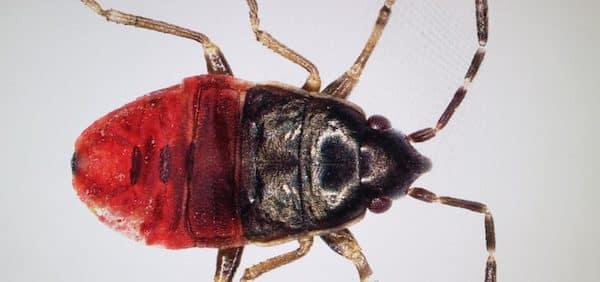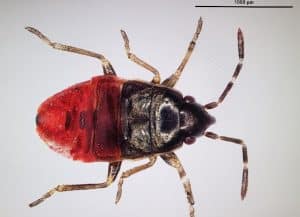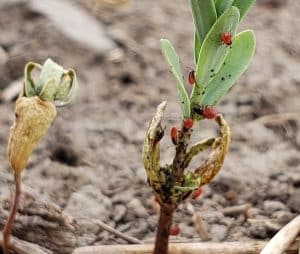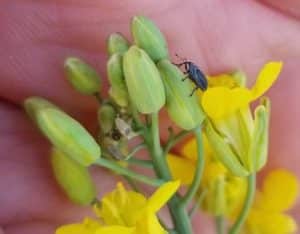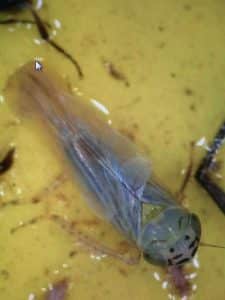Little red bugs. AAFC Saskatoon entomologist Tyler Wist provides this update, which he titles, “Mystery Twitter ‘Red Bug’ no longer a mystery”. Wist writes:
In 2017, Western Canadian agriculture was introduced to a “new” pest that didn’t seem to be confined to feeding on one crop. Often though, reports were of feeding in canola. Reports of this insect increased in 2018 and it’s back again in 2019. The insect is a true bug, Peritrechus convivus, and these and other closely related insects are commonly referred to as ‘dirt-coloured seed bugs’. Dirt-coloured? But these insects are red and we are not in P.E.I.? The adults are dirt-coloured and very well camouflaged in the soil while the nymphs (Fig.1) have red abdomens with subtle black stripes and black thoraxes.
An ongoing 2019 “Twittervestigation” (@TylerWist1) is attempting to deduce the distribution and agricultural significance of this insect. The bugs are appearing in fields slightly North of Saskatoon and East and West across central Saskatchewan. [And also in Manitoba.] Initially, the common theme was that crops planted onto lentil stubble had these insects and this seems to hold, but recent reports of wheat on canola and canola on wheat and even alfalfa on alfalfa harbouring P. convivus confuse that theme. Flax fields (Fig. 2) have been taking damage from the piercing-sucking feeding of this bug, as well as canola and a few wheat fields. Larson and Scudder* (2018) published a wealth of information on seed bugs, including some insight into the life history of P. convivus. They overwinter as adults under field trash and I’ve been finding adults mixed in with various stages of nymphs so they may have an extended egg laying period. Nymphs feed on emergent vegetation, and newly sprouted crops fit that description. These insects are also associated with slough edges, so I’ve started asking producers if the pockets of P. convivus (and they do seem to congregate in patches) are associated with low, wet spots that they have reclaimed after several dry years. Thanks to everyone who answered my Twitter call for ‘red bug reports with pictures for confirmation of the insect’s identity. *Larson, D.J., Scudder, G.G.E. 2018. Seed Bugs and their allies (Hemiptera: Heteroptera: Lygaeoidea) of the Canadian Prairie Provinces. Canadian Journal of Arthropod Identification 34.
Cabbage seedpod weevil. CSPW tend to cluster in fields that are first to flower, so farmers with early fields will want to check them closely. Scout at 10-20% flower (or approximately one week after first flower) using a sweep net. The economic threshold is 25-40 CSPW per 10 sweeps generally across the field.
How to scout for CSPW:
–Scout in the spring using a sweep net when the crop first enters the bud stage and continue through the flowering period. Proper sweet net technique.
–Select four locations within each field- two paired locations separated by 50 m with each pair in a distinctly different portion of the field. At each location count the number of weevils from ten 180° sweeps with a sweep net.
–Sweep between 11 am and 5 pm (when temperatures are above 20°C), when the insects will be most active, making sweep counts more accurate.
–The action threshold for applying insecticides is 25-40 weevils in 10 sweeps during canola flowering. This range should allow for changes in canola price and cost of control. Read more in the Canola Encyclopedia.
Grasshoppers. Smaller nymphs are feeding on various crops. It came up on #abbugchat on Twitter this week. Grasshoppers are often worse in hot, dry conditions. One big reason is because insects, as cold-blooded creatures, eat more and grow faster in hot weather. The other reason is that hot, dry weather limits fungal infection, one of the main threats to grasshoppers. In dry weather, a larger proportion of eggs hatch. Read more.
Aster leafhoppers. Tyler Wist, AAFC Saskatoon, also provides the following update on aster leafhoppers (Macrosteles quadrilineatus): Aster leafhoppers have not had any sustained migrations on the winds into Western Canada and only a smattering have been caught on yellow sticky cards and sweep net sampling in ditches. (Diamondback moths are also being monitored at many of these sites and they are also only showing up in very small numbers as well.) Only one of the aster leafhoppers tested positive at the AAFC SRDC lab for the aster yellows phytoplasma. Low numbers of leafhoppers mean that currently, the aster yellows threat index in very low. Thanks to everyone who has helped with trapping across Saskatchewan and Alberta and please let me know if you are interested in joining the trapping network or continuing sticky card and diamondback moth trapping past the provincial end dates (tyler.wist@canada.ca).
